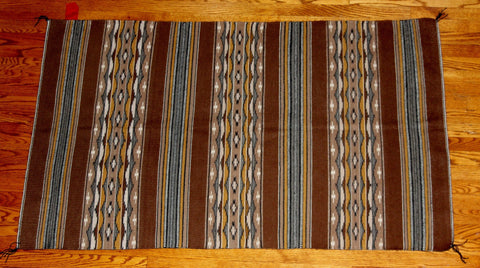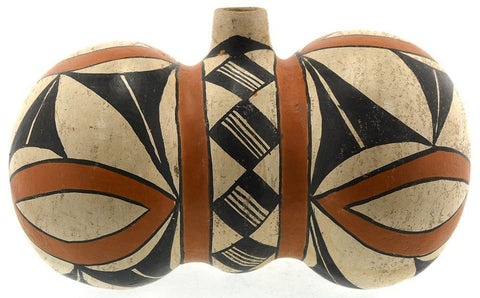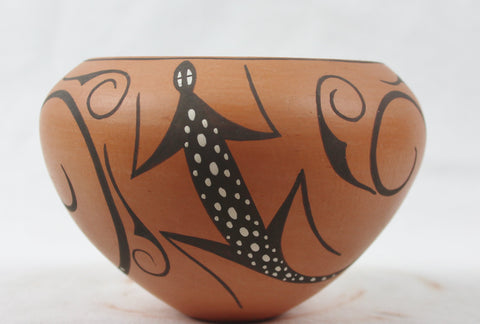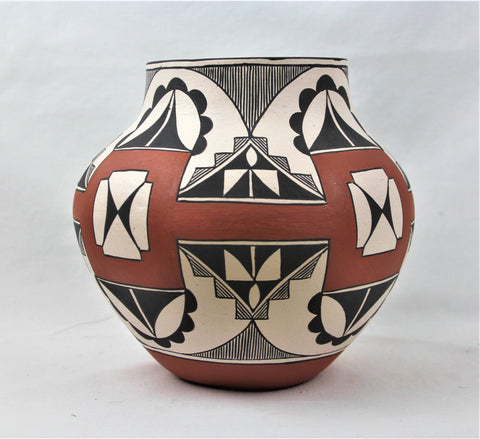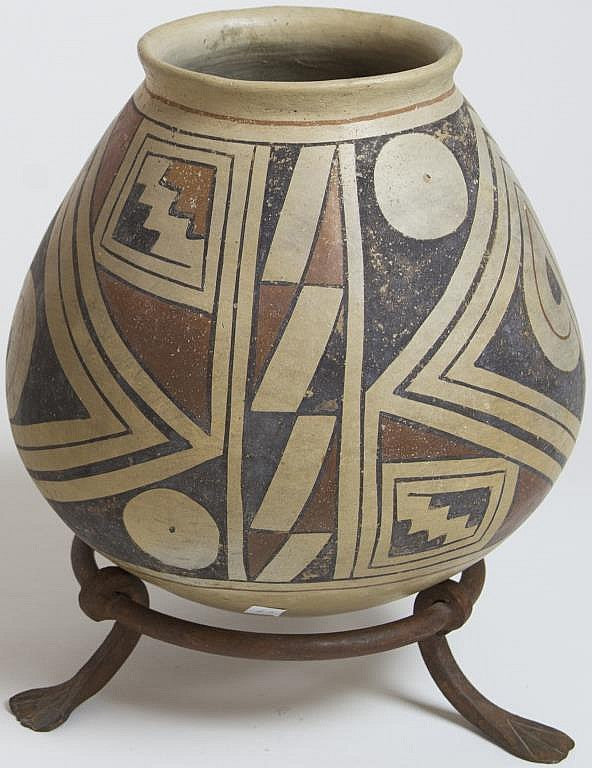
Casas Grandes, Historic Poly Chrome Pottery Jar, #1101 sold
$ 3,000.00
Casas Grandes,
Historic Poly Chrome Pottery Jar, #1101
Description: #1101 Casas Grandes, Historic Poly Chrome Pottery Jar, blace on buff background, round bottom on a woven straw circular base.
Condition: Some design ware, but overall in very good condition for age/
Dimensions: 9 H, 8 ½ DIA.
Some background on Casas Grande Follows:
Paquim̩, better known as Casas Grandes, was a major cultural and trade center in the northwestern region of today's Chihuahua state for hundreds of years before the arrival of the Spanish in northern Mexico. Culturally affiliated in many ways to Mesoamerica to the south, Casa Grandes acted as an intermediary between Central American peoples and the Mogollon and Hohokam peoples to the north.
Its area of influence reached from central New Mexico in the north to central Chihuahua in the south. Its peak of development occurred in the 13th and 14th centuries. Trade items included shells, copper, pottery, and macaws. The ruins of Paquim̩ include more than 2000 rooms, indicating the importance of this settlement.
Casas Grandes is known for its remarkable pottery. Today, residents of the neighboring village of Mata Ortiz create pottery inspired by Casas Grandes work, and this pottery is in high demand. (Source: university of Texas at El Paso).
Pueblo pottery is made using a coiled technique that came into northern Arizona and New Mexico from the south, some 1500 years ago. In the four-corners region of the US, nineteen pueblos and villages have historically produced pottery. Although each of these pueblos use similar traditional methods of coiling, shaping, finishing and firing, the pottery from each is distinctive. Various clay's gathered from each pueblo's local sources produce pottery colors that range from buff to earthy yellows, oranges, and reds, as well as black. Fired pots are sometimes left plain and other times decorated most frequently with paint and occasionally with applique. Painted designs vary from pueblo to pueblo, yet share an ancient iconography based on abstract representations of clouds, rain, feathers, birds, plants, animals and other natural world features.
Tempering materials and paints, also from natural sources, contribute further to the distinctiveness of each pueblo's pottery. Some paints are derived from plants, others from minerals. Before firing, potters in some pueblos apply a light colored slip to their pottery, which creates a bright background for painted designs or simply a lighter color plain ware vessel. Designs are painted on before firing, traditionally with a brush fashioned from yucca fiber.
Different combinations of paint color, clay color, and slips are characteristic of different pueblos. Among them are black on cream, black on buff, black on red, dark brown and dark red on white (as found in Zuni pottery), matte red on red, and poly chrome a number of natural colors on one vessel (most typically associated with Hopi). Pueblo potters also produce un-decorated polished black ware, black on black ware, and carved red and carved black wares.
Making pueblo pottery is a time-consuming effort that includes gathering and preparing the clay, building and shaping the coiled pot, gathering plants to make the colored dyes, constructing yucca brushes, and, often, making a clay slip. While some Pueblo artists fire in kilns, most still fire in the traditional way in an outside fire pit, covering their vessels with large potsherds and dried sheep dung. Pottery is left to bake for many hours, producing a high-fired result.
Today, Pueblo potters continue to honor this centuries-old tradition of hand-coiled pottery production, yet value the need for contemporary artistic expression as well. They continue to improve their style, methods and designs, often combining traditional and contemporary techniques to create striking new works of art. (Source: Museum of Northern Arizona)
Historic Poly Chrome Pottery Jar, #1101
Description: #1101 Casas Grandes, Historic Poly Chrome Pottery Jar, blace on buff background, round bottom on a woven straw circular base.
Condition: Some design ware, but overall in very good condition for age/
Dimensions: 9 H, 8 ½ DIA.
Some background on Casas Grande Follows:
Paquim̩, better known as Casas Grandes, was a major cultural and trade center in the northwestern region of today's Chihuahua state for hundreds of years before the arrival of the Spanish in northern Mexico. Culturally affiliated in many ways to Mesoamerica to the south, Casa Grandes acted as an intermediary between Central American peoples and the Mogollon and Hohokam peoples to the north.
Its area of influence reached from central New Mexico in the north to central Chihuahua in the south. Its peak of development occurred in the 13th and 14th centuries. Trade items included shells, copper, pottery, and macaws. The ruins of Paquim̩ include more than 2000 rooms, indicating the importance of this settlement.
Casas Grandes is known for its remarkable pottery. Today, residents of the neighboring village of Mata Ortiz create pottery inspired by Casas Grandes work, and this pottery is in high demand. (Source: university of Texas at El Paso).
Pueblo pottery is made using a coiled technique that came into northern Arizona and New Mexico from the south, some 1500 years ago. In the four-corners region of the US, nineteen pueblos and villages have historically produced pottery. Although each of these pueblos use similar traditional methods of coiling, shaping, finishing and firing, the pottery from each is distinctive. Various clay's gathered from each pueblo's local sources produce pottery colors that range from buff to earthy yellows, oranges, and reds, as well as black. Fired pots are sometimes left plain and other times decorated most frequently with paint and occasionally with applique. Painted designs vary from pueblo to pueblo, yet share an ancient iconography based on abstract representations of clouds, rain, feathers, birds, plants, animals and other natural world features.
Tempering materials and paints, also from natural sources, contribute further to the distinctiveness of each pueblo's pottery. Some paints are derived from plants, others from minerals. Before firing, potters in some pueblos apply a light colored slip to their pottery, which creates a bright background for painted designs or simply a lighter color plain ware vessel. Designs are painted on before firing, traditionally with a brush fashioned from yucca fiber.
Different combinations of paint color, clay color, and slips are characteristic of different pueblos. Among them are black on cream, black on buff, black on red, dark brown and dark red on white (as found in Zuni pottery), matte red on red, and poly chrome a number of natural colors on one vessel (most typically associated with Hopi). Pueblo potters also produce un-decorated polished black ware, black on black ware, and carved red and carved black wares.
Making pueblo pottery is a time-consuming effort that includes gathering and preparing the clay, building and shaping the coiled pot, gathering plants to make the colored dyes, constructing yucca brushes, and, often, making a clay slip. While some Pueblo artists fire in kilns, most still fire in the traditional way in an outside fire pit, covering their vessels with large potsherds and dried sheep dung. Pottery is left to bake for many hours, producing a high-fired result.
Today, Pueblo potters continue to honor this centuries-old tradition of hand-coiled pottery production, yet value the need for contemporary artistic expression as well. They continue to improve their style, methods and designs, often combining traditional and contemporary techniques to create striking new works of art. (Source: Museum of Northern Arizona)
Related Products
Sold out
Sold out
Sold out

